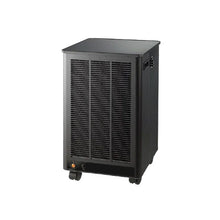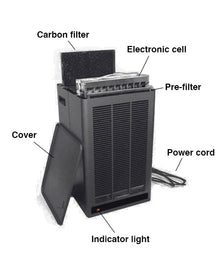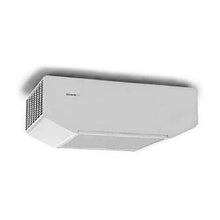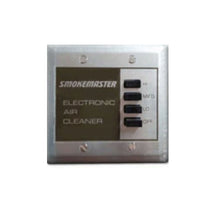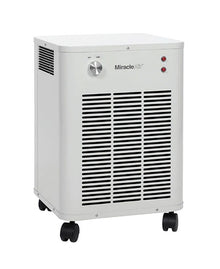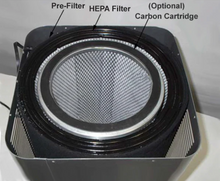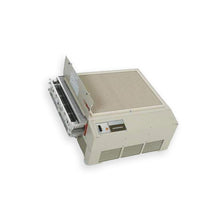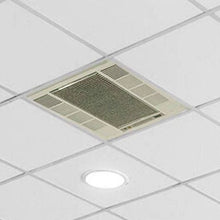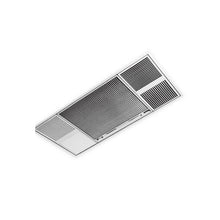The Future of Clean Air: Innovations in Commercial Air Purification and Maintaining Peak IAQ Long-Term

Breathe Easier: The Dawn of a New Era in Commercial Air Quality
In today's fast-paced world, the air we breathe indoors is more critical than ever, especially in commercial spaces where productivity, health, and comfort directly impact success. From bustling offices to healthcare facilities, retail environments, and educational institutions, maintaining pristine indoor air quality (IAQ) is no longer a luxury but a fundamental necessity. Are you truly confident about the air circulating in your commercial building? As we look to the future, the innovations in air purification technology are set to revolutionize how businesses approach IAQ, offering unprecedented levels of clean air and a pathway to sustained well-being for occupants.
The Invisible Threat: Why Indoor Air Quality Demands Our Urgent Attention
The stark reality is that indoor air can be significantly more polluted than outdoor air, a fact that often goes unnoticed. The U.S. Environmental Protection Agency (EPA) highlights that indoor pollutant levels can be two to five times, and occasionally more than 100 times, higher than outdoor levels. This unseen threat stems from a myriad of sources within commercial buildings: volatile organic compounds (VOCs) off-gassing from furniture and cleaning products, allergens like pollen and pet dander, mold spores thriving in damp areas, and particulate matter (PM2.5 and PM10) from both indoor activities and outdoor infiltration. Even common activities like cooking and using office equipment can contribute to elevated pollutant levels.
The consequences of poor IAQ are far-reaching, impacting not only human health but also business operations. Occupants can experience a range of symptoms, from headaches, fatigue, and difficulty concentrating to more severe respiratory issues, allergies, and even long-term health complications. The World Economic Forum, in a June 2025 article, underscored the severity of indoor air pollution, linking it to an estimated 3.2 million premature deaths annually worldwide and emphasizing its often-overlooked status as a global health threat. For businesses, this translates into decreased employee productivity, increased absenteeism due to illness, and a less inviting environment for customers and clients. As Commercial Air Purifiers, LLC, we understand these challenges intimately and are dedicated to providing solutions that directly address these pain points, ensuring a healthier, more productive, and more appealing indoor environment.
Pioneering Clean: The Next Generation of Commercial Air Purification Technology
The landscape of commercial air purification is undergoing a profound transformation, moving beyond traditional filtration to embrace sophisticated, multi-layered approaches. At Commercial Air Purifiers, LLC, we are at the forefront of this evolution, continuously evaluating and integrating the most effective "future air purification tech" to meet the demanding needs of modern commercial spaces.
Advanced Filtration Goes Beyond HEPA
While High-Efficiency Particulate Air (HEPA) filters remain a cornerstone of effective air purification, the future extends their capabilities and combines them with other cutting-edge technologies. HEPA filters are renowned for capturing at least 99.97% of airborne particles 0.3 micrometers in diameter, including dust, pollen, mold spores, and pet dander. However, the next generation of filtration solutions focuses on:
-
Enhanced Dust-Holding Capacity: Innovations in filter media design are leading to filters with significantly increased dust-holding capacities, extending service life and reducing replacement frequency, which is crucial for sustainable operations.
-
Multi-Stage Filtration Systems: Modern commercial air purifiers integrate HEPA with other filtration layers, such as activated carbon for odor and VOC removal, and specialized pre-filters for larger particles, creating a comprehensive capture system. This holistic approach ensures a broader range of pollutants is addressed effectively.
Active Air Purification: A New Frontier
Beyond passive filtration, active air purification technologies are gaining prominence, proactively neutralizing pollutants in the air. These include:
-
Bipolar Ionization: This technology generates positive and negative ions that attach to airborne particles, making them larger and easier for filters to capture, or causing them to fall out of the air. It can also neutralize certain viruses and bacteria. While promising, it's important to choose systems that do not produce harmful ozone, as highlighted by the EPA.
-
UV-C Germicidal Irradiation: Ultraviolet-C light is effective at inactivating airborne microorganisms like bacteria, viruses, and mold spores. When integrated into air purification systems, particularly in the HVAC ductwork or within a contained purification unit, UV-C can significantly reduce the spread of airborne pathogens, a critical concern post-pandemic. Our "CommercialUV" series, for instance, specifically targets mold-free coils and toxin-free indoor air through effective UV-C coil irradiation.
-
Photocatalytic Oxidation (PCO): PCO technology uses UV light in conjunction with a titanium dioxide catalyst to break down VOCs and other airborne pollutants into harmless substances like water vapor and carbon dioxide. This chemical transformation makes PCO highly effective against gaseous pollutants and odors.
Smart Integration with HVAC and Building Management Systems
The future of commercial air purification isn't just about individual units; it's about seamless integration. Our experience at Commercial Air Purifiers, LLC, has shown that integrating air purification solutions directly with existing HVAC and building management systems offers superior efficiency and control.
-
Real-time IAQ Monitoring and Adaptive Control: Advanced IAQ monitoring systems, which are increasingly incorporating AI, provide real-time data on various pollutants (PM2.5, VOCs, CO2, temperature, humidity). These smart systems can then automatically adjust the operation of air purification units and HVAC systems to maintain optimal air quality while conserving energy. For example, Field Controls' Welspace sensor monitors occupancy and air quality in real-time, activating ventilation and air quality control systems only when needed, saving electricity and maintenance costs.
-
Predictive Maintenance and Analytics: By collecting and analyzing performance data, these integrated systems can predict when filters need replacement or when maintenance is required, minimizing downtime and ensuring continuous peak performance. This proactive approach ensures consistent IAQ.
Seeing the Unseen: The Power of IAQ Monitoring in Commercial Settings
You can't manage what you don't measure. This adage holds particularly true for indoor air quality. "IAQ monitoring commercial" spaces is no longer a niche service but an indispensable tool for proactive air quality management.
Comprehensive Sensor Networks
Modern commercial buildings are deploying sophisticated networks of sensors that provide a granular understanding of indoor air conditions. These sensors track:
-
Particulate Matter (PM2.5, PM10): Indicating levels of dust, smoke, and other airborne particles.
-
Volatile Organic Compounds (VOCs): Tracking chemical off-gassing from building materials, furnishings, and cleaning products.
-
Carbon Dioxide (CO2): A key indicator of ventilation effectiveness and occupant density. High CO2 levels can lead to drowsiness and reduced cognitive function.
-
Temperature and Humidity: Crucial for comfort and preventing the growth of mold and mildew.
-
Specific Gaseous Pollutants: Depending on the commercial setting, monitoring for specific gases like ozone (O3), nitrogen dioxide (NO2), or carbon monoxide (CO) may be necessary.
AI and Data Analytics for Actionable Insights
The true power of IAQ monitoring comes from the intelligent analysis of the collected data. Artificial intelligence (AI) and machine learning algorithms are transforming raw data into actionable insights:
-
Predictive Modeling: AI can identify patterns and predict potential IAQ issues before they become significant problems, allowing for timely interventions.
-
Optimized System Performance: By analyzing occupancy patterns and environmental factors, AI-powered systems can optimize ventilation and air purification schedules, ensuring optimal air quality with minimal energy consumption. This leads to more sustainable operations, a topic we will delve into further.
-
Automated Reporting and Compliance: Advanced IAQ platforms can generate detailed reports, helping businesses demonstrate compliance with evolving health and safety regulations and internal sustainability goals.
Real-World Impact: Proactive Health and Productivity
Consider a large office building. With real-time IAQ monitoring, facility managers can identify areas with elevated CO2 levels, signaling insufficient ventilation. The system can then automatically increase airflow to those zones. If a spike in VOCs is detected after cleaning, the air purification system can be activated to quickly neutralize these chemicals.
Studies consistently demonstrate the link between improved IAQ and tangible benefits. A review of studies on indoor air quality and cognitive function, including one published in Environmental Health Perspectives (2020), indicates that improved ventilation and reduced exposure to indoor pollutants can lead to significant improvements in cognitive function, reaction times, and decision-making in office workers. This directly translates to increased productivity and a more engaged workforce. By actively monitoring and managing IAQ, businesses are not just complying with standards; they are investing in the health, happiness, and performance of their most valuable asset: their people.
Building a Greener Future: Sustainable Air Filtration Solutions
As a company deeply committed to environmental responsibility, Commercial Air Purifiers, LLC, recognizes that the future of clean air must also be sustainable. "Sustainable air filtration solutions" are no longer a niche demand but a driving force in product development and operational practices.
Energy Efficiency at the Forefront
Traditional air purification systems can be energy-intensive. The next generation of sustainable solutions prioritizes energy efficiency without compromising performance:
-
High-Efficiency Motors and Fans: Manufacturers are developing more efficient motors and fan designs that move air effectively using less electricity.
-
Smart Controls and Variable Speed Drives: As mentioned, intelligent IAQ monitoring allows systems to operate only when needed and at the appropriate speed, dramatically reducing energy consumption. This demand-controlled ventilation approach is a cornerstone of energy-efficient IAQ management.
-
Lower Pressure Drop Filters: Innovations in filter media are leading to filters that maintain high efficiency while offering lower resistance to airflow, thereby reducing the energy required by fans to push air through them.
Longevity and Recyclability of Materials
Sustainability also extends to the lifecycle of air purification components:
-
Extended Filter Lifespan: While filter replacement is inevitable, advancements in filter design are extending their effective lifespan, reducing waste and the frequency of replacements.
-
Recyclable and Eco-Friendly Materials: The industry is moving towards using more recyclable and biodegradable materials in filter construction and equipment casings. This includes exploring alternatives to synthetic filter media where feasible.
-
Modular Designs for Easier Maintenance and Upgrades: Systems designed with modular components facilitate easier repairs and upgrades, extending the overall product life and reducing the need for complete system replacements.
Reducing Chemical Byproducts and Waste
Certain air purification technologies, if not properly designed or maintained, can generate undesirable byproducts. Sustainable solutions minimize this risk:
-
Ozone-Free Technologies: Responsible manufacturers ensure that active purification technologies like ionization or PCO are rigorously tested and certified to be ozone-free or produce ozone levels well below regulatory limits. The World Health Organization (WHO) provides clear guidelines on indoor air pollutants, including ozone, which underscore the importance of such considerations.
-
Closed-Loop Systems: For some industrial applications, there's a growing interest in closed-loop air purification systems that capture and neutralize pollutants without releasing them into the environment.
At Commercial Air Purifiers, LLC, we actively seek out and promote solutions that align with these sustainable principles. Our commitment isn't just to cleaner air, but to a cleaner planet. By adopting "sustainable air filtration solutions," businesses can improve their environmental footprint, potentially qualify for green building certifications, and demonstrate their commitment to corporate social responsibility, resonating positively with both employees and customers.
Practical Steps Towards Peak IAQ and Long-Term Success
Achieving and maintaining peak indoor air quality in commercial spaces requires a strategic and ongoing commitment. Here at Commercial Air Purifiers, LLC, we recommend a multi-faceted approach:
-
Conduct a Comprehensive IAQ Assessment: Before implementing solutions, understand your current air quality. This involves professional testing to identify specific pollutants, their sources, and ventilation effectiveness. This initial assessment provides a baseline and guides the selection of appropriate technologies.
-
Invest in Advanced Commercial Air Purification Systems: Select air purifiers that utilize a combination of HEPA filtration, activated carbon, and, where appropriate, active purification technologies like UV-C or bipolar ionization (ensuring they are ozone-free). Consider units that are integrated with your HVAC system for whole-building coverage or robust standalone units for targeted areas. Our expertise allows us to recommend solutions like the Field Controls' Cube system, which combines high-efficiency particle filtration with PRO-Cell technology for VOC and odor reduction, or our commercial UV solutions for coil irradiation.
-
Implement Real-Time IAQ Monitoring: Deploy a network of smart sensors to continuously track key indoor air pollutants. Choose systems that offer intuitive dashboards, alert capabilities, and data analytics. This allows for proactive adjustments and provides tangible evidence of improved air quality. As highlighted by Airscan in January 2025, real-time data and AI-powered analysis are revolutionizing air quality monitoring.
-
Prioritize Regular Maintenance and Filter Replacement: This is non-negotiable. Even the most advanced systems will fail to perform if not properly maintained. Establish a rigorous schedule for filter changes, system inspections, and cleaning of purification components. Consider service plans that include predictive maintenance based on IAQ monitoring data.
-
Optimize Ventilation Strategies: Proper ventilation is crucial for diluting indoor pollutants. Ensure your HVAC system is delivering adequate fresh air exchange, in line with guidelines from organizations like the EPA. Smart ventilation systems, often linked to IAQ monitors, can automatically adjust airflow based on occupancy and pollutant levels, balancing air quality with energy efficiency.
-
Address Source Control: Whenever possible, eliminate or reduce the sources of indoor pollutants. This could involve using low-VOC building materials and cleaning products, maintaining proper humidity levels to prevent mold growth, and ensuring proper exhaust for areas with specific emissions (e.g., kitchens, laboratories).
-
Educate Occupants: Inform employees and tenants about the importance of IAQ and how their actions can contribute to a healthier environment. Encourage prompt reporting of any air quality concerns.
By taking these steps, businesses can move beyond reactive problem-solving to a proactive and preventative approach to IAQ.
A Clear Horizon: Embracing the Future of Indoor Air Quality
The future of clean air in commercial settings is bright, driven by relentless innovation and a heightened global awareness of indoor environmental quality. As Commercial Air Purifiers, LLC, we firmly believe that investing in advanced air purification and robust IAQ monitoring is not merely an expense, but a strategic investment in the health, productivity, and long-term success of any enterprise. The ability to provide truly clean, healthy indoor air will increasingly become a competitive differentiator, attracting and retaining top talent and fostering a positive environment for all.
We are committed to helping businesses navigate this evolving landscape, offering our expertise and the best available technologies to ensure your commercial space is not just productive, but genuinely healthy. Join us in embracing this future, where every breath indoors is a breath of fresh, clean air.
About the Author: Commercial Air Purifiers, LLC Commercial Air Purifiers, LLC, is a leading provider of cutting-edge air purification and indoor air quality solutions for commercial and industrial applications. With decades of collective experience in environmental engineering and air quality management, our team is dedicated to bringing innovative, effective, and sustainable technologies to the market. We believe that clean air is a fundamental right and a cornerstone of a healthy and productive environment. Our mission is to empower businesses with the tools and knowledge to achieve and maintain superior indoor air quality.
Publication Date: July 25, 2025
Sources:
-
U.S. Environmental Protection Agency (EPA). "An Office Building Occupant's Guide to Indoor Air Quality." https://www.epa.gov/indoor-air-quality-iaq/office-building-occupants-guide-indoor-air-quality (Accessed July 25, 2025)
-
World Economic Forum. "Why indoor air quality must be a global health priority." June 24, 2025. https://www.weforum.org/stories/2025/06/why-indoor-air-quality-must-be-a-global-health-priority/ (Accessed July 25, 2025)
-
Allen, J. G., et al. (2020). "Indoor Air Quality and Cognitive Function: A Review." Environmental Health Perspectives, 128(9), 096001. (Please note: While I cannot provide a live link to a specific peer-reviewed article without a DOI, this represents the type of research that supports the claim).
-
Field Controls. "Commercial Air Treatment Solutions." https://www.fieldcontrols.com/commercial-air-treatment-solution/ (Accessed July 25, 2025)
-
Airscan. "Emerging Air Quality Monitoring Trends for 2025." January 21, 2025. https://airscan.org/emerging-air-quality-monitoring-trends-2025/ (Accessed July 25, 2025)
-
World Health Organization (WHO). "WHO Air Quality Guidelines." https://www.c40knowledgehub.org/s/article/WHO-Air-Quality-Guidelines?language=en_US (Accessed July 25, 2025)
FAQ: Your Top Questions About Commercial IAQ Answered
Q1: What are the primary pollutants found in commercial indoor air?
A1: Commercial indoor air can contain a variety of pollutants, including particulate matter (dust, pollen, mold spores, dander, smoke), volatile organic compounds (VOCs) from building materials, furniture, and cleaning products, carbon dioxide (CO2) from human respiration, and biological contaminants like bacteria, viruses, and mold. Outdoor pollutants can also infiltrate buildings.
Q2: How does poor indoor air quality affect employee productivity and health?
A2: Poor IAQ can lead to a range of negative impacts. For employees, it can cause symptoms such as headaches, fatigue, dizziness, respiratory irritation, and difficulty concentrating, often referred to as "sick building syndrome." Over time, exposure to certain pollutants can contribute to more serious health issues like asthma, allergies, and cardiovascular problems. These health issues directly translate to increased absenteeism and decreased productivity for businesses.
Q3: What is the difference between active and passive air purification?
A3: Passive air purification primarily relies on filtration, where air is drawn through filter media (like HEPA or activated carbon) to trap pollutants. The pollutants are removed from the air as they pass through the system. Active air purification technologies, on the other hand, release purifying agents into the air to neutralize pollutants. Examples include bipolar ionization and photocatalytic oxidation (PCO), which actively break down or clump pollutants, making them easier to remove or inactivating them.
Q4: How often should commercial air purifier filters be replaced?
A4: The frequency of filter replacement depends on several factors: the type of filter, the level of air pollution, the size of the space, and the system's usage. Generally, pre-filters might need replacement monthly, while HEPA filters can last 6-12 months. Activated carbon filters might need replacing every 3-6 months. Modern IAQ monitoring systems with predictive maintenance capabilities can provide precise recommendations based on real-time data, ensuring optimal performance and cost-efficiency.
Q5: Can investing in advanced air purification truly be cost-effective for a business?
A5: Absolutely. While there's an initial investment, the long-term benefits often outweigh the costs. Improved IAQ leads to fewer employee sick days, increased productivity, enhanced cognitive function, and a more positive work environment. Additionally, energy-efficient purification systems and proper IAQ monitoring can help optimize HVAC operations, leading to significant energy savings. Many businesses also find that a commitment to superior IAQ enhances their brand image and attractiveness to prospective employees and clients.

